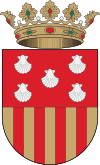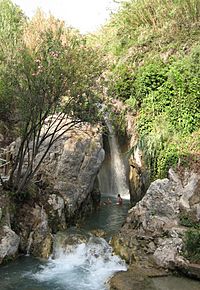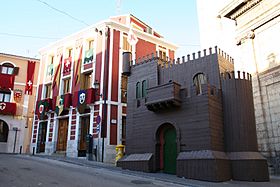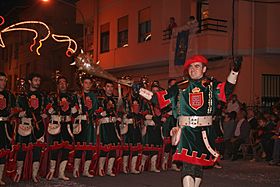Callosa d'en Sarrià facts for kids
Quick facts for kids
Callosa d'en Sarrià
|
||
|---|---|---|
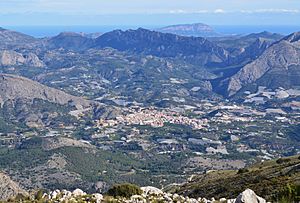 |
||
|
||
| Country | ||
| Autonomous community | ||
| Province | Alicante | |
| Comarca | Marina Baixa | |
| Judicial district | Villajoyosa | |
| Area | ||
| • Total | 34.66 km2 (13.38 sq mi) | |
| Elevation | 247 m (810 ft) | |
| Population
(2018)
|
||
| • Total | 7,257 | |
| • Density | 209.38/km2 (542.28/sq mi) | |
| Demonym(s) | Callosí, callosina | |
| Time zone | UTC+1 (CET) | |
| • Summer (DST) | UTC+2 (CEST) | |
| Postal code |
03510
|
|
| Official language(s) | Valencian | |
Callosa d'en Sarrià is a lovely town in the Valencian Community of Spain. It is part of the Marina Baixa area in the Alicante province. The town sits in the valley of the Guadalest River, about 50 kilometers from the city of Alicante.
Callosa d'en Sarrià covers an area of 24.8 square kilometers. In 2003, about 8,060 people lived there. The town's economy mainly relies on tourism and agriculture. It is famous for being the biggest producer of a fruit called loquat in Spain. Important landmarks include the Sant Joan Baptista (Saint John) church, built in the 1700s. There is also the Fortress of Bèrnia, built in the 1600s to protect the town from pirates.
Contents
Discovering Callosa d'en Sarrià
Callosa d'en Sarrià is surrounded by the mountains of Aitana, Bèrnia, and Xortà. The Guadalest and Algar rivers flow through the town. The weather is Mediterranean, meaning mild winters and warm summers. January temperatures average 17°C, while summer highs reach 24°C. Winter lows are around 9.5°C.
Getting to Callosa d'en Sarrià
The town is about 10 kilometers from the coast. You can reach it by road from nearby cities. For example, from Alicante, you can take the AP-7 highway or the N-332 road to Benidorm. From there, you follow the CV-70 and then the CV-715 roads.
Neighboring Towns
Callosa d'en Sarrià shares its borders with several other towns. These include Altea, Bolulla, Guadalest, Xaló, La Nucia, Polop, and Tàrbena.
A Glimpse into Callosa's Past
People have lived in the Callosa area for a very long time. Scientists have found signs of human settlements from the Stone Age (around 5,000 BC), the Bronze Age, and the Roman times. These early settlements later became small Muslim villages.
How Callosa Got Its Name
The name "Callosa" likely means "hard, dry land" in Latin. The town started as an old Muslim farm. After King James I of Aragon took over in the 1200s, a Christian admiral named Bernat de Sarrià bought the land in 1290. He became the first feudal lord, like a powerful landowner. Because of him, the town was renamed Callosa d'en Sarrià. It became the main center for this lord's lands, which covered much of the current Marina Baixa area.
Noble Families and the Town
Over time, different noble families owned Callosa. These included the Sarrià family, the Crown of Aragon (the king's land), the Bou family, and the Moncada family. Today, the noble title for the town belongs to the Valldaura Crespí family.
The old part of Callosa still looks like a medieval town. It was once surrounded by walls. You can still enter through one of its original gates, called El Portal.
People of Callosa
In 2010, Callosa d'en Sarrià had 7,888 residents. About 30% of the people living there were from other countries. Many came from Latin American countries like Ecuador and Bolivia, and also from other parts of Europe.
| Population Changes in Callosa d'en Sarrià | |||||||||||||||||||
|---|---|---|---|---|---|---|---|---|---|---|---|---|---|---|---|---|---|---|---|
| Year | 1857 | 1887 | 1900 | 1910 | 1920 | 1930 | 1940 | 1950 | 1960 | 1970 | 1981 | 1991 | 2000 | 2005 | 2008 | 2009 | 2010 | ||
| Population | 3.889 | 4.206 | 4.195 | 4.415 | 4.070 | 4.098 | 4.101 | 4.189 | 4.617 | 5.701 | 7.127 | 7.503 | 6.488 | 8.179 | 8.224 | 8.056 | 7.888 | ||
What Callosa is Known For
Callosa's economy is strong in agriculture, especially with loquats. This fruit was brought to Spain in the 1800s by Juan Bautista Berenguer y Ronda from Callosa. Farmers work together in a group to sell their fruits. Most of these fruits are sent to other countries, mainly France and Italy.
The local government has created a "denominación de origen" (DO) for loquats from Callosa. This means they set quality rules for loquats grown in the area. This helps make sure the loquats are always top quality.
In recent years, tourism has also grown a lot in Callosa. Many visitors come to enjoy the town and its natural beauty.
Amazing Places to Visit
Fonts de l’Algar (Algar Waterfalls)
The Fonts de l’Algar are beautiful waterfalls located 3 kilometers from Callosa's center. This area is a natural park. It is protected for its rich environment. It also offers services for tourists and teaches about nature.
Fortalesa de Bèrnia (Fortress of Bèrnia)
The Fortalesa de Bèrnia was built in 1562 by a royal engineer named Giovanni Battista Antonelli. It was a great example of military buildings from the Renaissance period. King Philip II of Spain ordered it built to protect the coast from attacks. However, it was too far from the coast and not very useful. So, in 1612, King Philip III ordered it to be taken down.
Today, you can still see parts of the fort. These include arches, the ditch, a strong wall section, a well, and parts of the main wall. The wall used to be 100 meters long and 100 meters wide. Since 1997, it has been recognized as an important cultural site. Signs at the fort explain how it used to work.
El Poador de la Font Major (The Old Washing Place)
This is an old washing place and water trough. It was built in 1786 by the town council. It once had twelve water spouts. Over seventy people could wash their clothes there at the same time.
In 1910, a roof was added to the washing place. Today, it has been restored. It is now one of the most charming and well-known spots in Callosa.
Sant Joan Baptista Church
The first records of the current church date back to 1574. That's when the first parish church was built. It was officially opened in 1578. Later, in the second half of the 1700s, people decided to make the church bigger. Work on the main part of the church began in 1765 and finished in 178. More work was done on the front of the church in 1819. They used local marble for this part, finishing it in 1865. The very top part of the front was added in 1917. For this, they used painted concrete to look like marble.
Remains of the Castle Wall
The first information about the castle is from 1322. It was given to Prince Don Pedro by Bernat de Sarrià, who was the Lord of Callosa and likely built it.
Different lords of Callosa owned the castle over the years. By the late 1600s, it started to fall apart. It completely disappeared in the early 1700s. Today, visitors can still see some parts of the old castle wall.
Fun Festivals and Traditions
- Festes de Sant Jaume: These festivals are also known as Les Danses de Sant Jaume or La Festa del Fadrí. They are the oldest festivals in Callosa and the region. A historian named Adolf Salvà found the first written mention of them in 1819. Like many old celebrations, their origin might be from ancient pagan rituals, perhaps honoring a god of fertility. Today, the festival honors Saint James. The Sant Jaume festivals are not just about dances. They are days of street celebrations with popular games like cucanyes (fun challenges) and Calitx (a coin game). There are also games of Valencian pilota, loquat and cake tasting, and a "rooster race" called correguda del gall.
- Moors and Christians: These celebrations have deep historical roots in Callosa. They have been held since 1860, usually on the second weekend of October. They are so important that they have been declared a National Tourist Interest since 1985. The festivals honor the Virgin of Injuries. Some of the most exciting parts are the colorful parades called Entrada Mora (Moorish Entry) and Entrada Cristiana (Christian Entry). These parades are led by old dances performed by Nanos, who also go with the Virgin during the procession. The dance of the Nanos happens before the parade and represents the older, pagan part of the festival.
Delicious Local Food
Callosa has many tasty traditional dishes. Here are some of them:
- Crosta: This is a special dish often eaten during Carnival. It is made with dry rice and includes ingredients like sausage. It's covered with beaten egg and baked in a clay pot.
- Minxos: These are small pastries filled with chopped vegetables and fish.
- Putxero (or olla) amb pilotas: This is a typical dish for the Moors and Christians festivals. It's similar to a Spanish stew. It has special meat and blood balls wrapped in cabbage leaves.
- Desserts: For sweet treats, try the pastissets d’aguardent i a l’aire. These are tiny cakes made with liquor. And of course, you must try the loquat fruit in all its forms. You can eat it fresh, in syrup, or in cakes.
How the Town is Governed
The town of Callosa d'en Sarrià is run by a local government. Here are the results from the local elections held on May 22, 2011:
| Results of local elections on May 22, 2011 | |||||
| Party | Candidate | Votes | % | Seats | |
| PP | Juan Bautista Saval Ferrando | 1.948 | 50,99 | 7 | |
| PSPV-PSOE | Alfonso Puigcerver Berenguer | 1.038 | 27,17 | 3 | |
| BLOC-Compromís | Vicent Llobell Bertomeu | 834 | 21,83 | 3 | |
| source: Generalitat Valenciana | |||||
Images for kids
See also
 In Spanish: Callosa de Ensarriá para niños
In Spanish: Callosa de Ensarriá para niños


